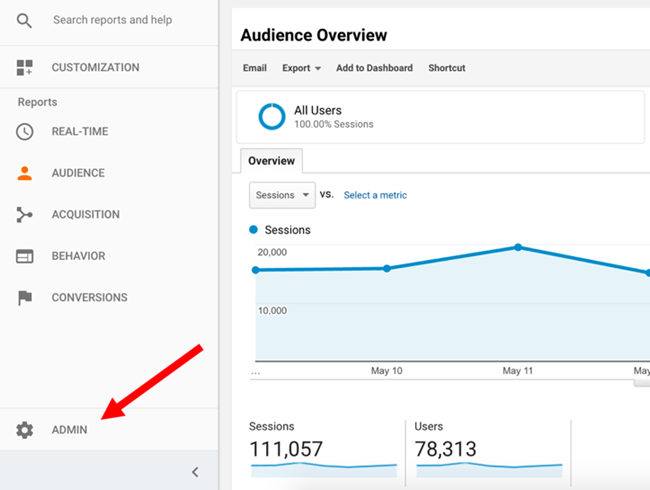Optimize Your ROI With Remarketing in Google Analytics
In the world of digital advertising and marketing, the use of remarketing approaches within Google Analytics has confirmed to be a potent device for boosting roi. By harnessing the power of customer information and tailoring advertisements to details target market sections, organizations can considerably intensify their conversion rates. The genuine crucial lies in the art of precision - recognizing user behavior, crafting engaging advertisements, and continuously refining strategies to drive optimum outcomes. The journey to maximizing ROI with remarketing is a nuanced course paved with understandings and possibilities that can reshape the trajectory of your advertising and marketing endeavors.
Comprehending Remarketing in Google Analytics
Comprehending remarketing in Google Analytics is necessary for maximizing your electronic advertising technique. Remarketing allows you to target users who have actually previously visited your website or connected with your application, providing them with customized ads as they search other websites or use other apps within the Google Display Network. This approach aids keep your brand name top of mind and urges individuals to return to your site, ultimately enhancing the likelihood of conversion.
By utilizing Google Analytics, you can track the efficiency of your remarketing campaigns, gaining important understandings right into customer behavior, interaction, and conversions. This data allows you to fine-tune your messaging, bidding, and targeting techniques to boost the overall performance of your campaigns.
Additionally, recognizing the different kinds of remarketing lists available in Google Analytics, such as conventional, vibrant, and similar target markets, permits you to produce extremely fractional and personalized projects customized to specific user sections. This level of granularity can substantially improve the significance and influence of your remarketing efforts, inevitably optimizing your return on investment.
Establishing Up Remarketing Checklists
To effectively carry out remarketing campaigns in Google Analytics, the initial action involves configuring and producing remarketing listings targeting specific user sectors based on their interactions with your internet site or application. By establishing remarketing checklists, you can tailor your advertising efforts to reach individuals who have actually currently revealed passion in your product and services.
To begin, browse to the Admin section of your Google Analytics account and pick the Residential property where you intend to develop the remarketing listing. Under the Home column, click on 'Target market Definitions' and choose 'Audiences.' Next off, click on the red 'New Audience' switch and choose 'Create New' to specify the parameters for your remarketing checklist.

Crafting Efficient Remarketing Ads

When crafting your advertisements, focus on creating attention-grabbing headings and compelling visuals that attract attention to prospective clients. Integrate solid calls-to-action that motivate individuals to revisit your site and finish a desired activity. Make use of vibrant remarketing to show customized ads including product and services that customers have formerly viewed on your website.
Furthermore, guarantee that your ads are mobile-friendly given that a significant section of web traffic comes from mobile phones. Test different advertisement variants pop over here to recognize which styles and messages drive the best results. By continuously refining and optimizing have a peek here your remarketing ads based upon efficiency information, you can optimize their effectiveness and boost your return on investment.
Analyzing Remarketing Performance

Via Google Analytics, marketers can track the performance of their remarketing campaigns in real-time, permitting them to identify fads, patterns, and areas for enhancement immediately. By examining the information, marketers can establish which ads are doing well, which audience sections are responding positively, and which networks are driving the most conversions. This degree of granularity enables here online marketers to make data-driven choices to optimize their remarketing projects for far better results.
Maximizing ROI With Remarketing
Assessing remarketing data in Google Analytics makes it possible for marketers to identify chances for optimizing roi (ROI) via strategic changes - What Is “Remarketing” In Google Analytics?. To maximize ROI with remarketing, it is crucial to comprehend the behavior of your target market. By evaluating individual communications, such as the web pages they went to, the items they watched, or the activities they handled your site, you can tailor your remarketing campaigns better
Segmenting your target market based on their habits allows you to create personalized and targeted advertisements that are much more most likely to resonate with them. By revealing pertinent ads to specific segments of your target market, you can increase the possibilities of conversion and inevitably enhance your ROI.
Additionally, examining various ad creatives, messaging, and offers can help recognize what reverberates best with your target market. A/B testing permits you to experiment with various aspects of your advertisements to determine what drives the highest possible interaction and conversion rates.
Conclusion
To conclude, making the most of ROI with remarketing in Google Analytics calls for a critical method to evaluating customer behavior, segmenting audiences, producing tailored advertisements, and enhancing project performance. By leveraging data-driven insights and evaluating various methods, businesses can improve their remarketing efforts to drive higher engagement and conversion rates. This organized approach guarantees that sources are efficiently assigned towards maximizing rois in remarketing campaigns.
Next off, click on the red 'New Audience' button and pick 'Develop New' to define the parameters for your remarketing listing.
By constantly refining and optimizing your remarketing advertisements based on efficiency data, you can optimize their effectiveness and boost your return on financial investment.
By delving right into these understandings, marketers can gain a detailed understanding of how their remarketing efforts are resonating with their target audience and driving conversions. To maximize ROI with remarketing, it is important to understand the actions of your target market.In conclusion, making the most of ROI with remarketing in Google Analytics requires a critical technique to evaluating individual behavior, segmenting target markets, developing customized advertisements, and optimizing campaign efficiency.